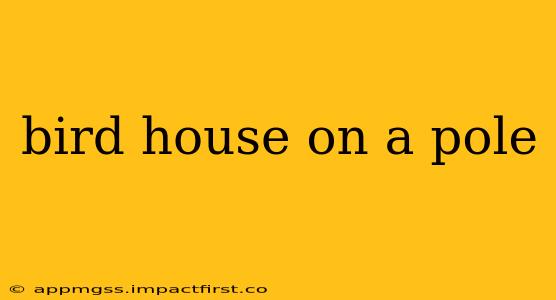Want to attract birds to your backyard and enjoy their cheerful songs? A birdhouse on a pole can be a fantastic way to achieve this. This comprehensive guide explores everything you need to know about installing and maintaining a birdhouse on a pole, ensuring you provide a safe and inviting haven for your avian neighbors.
Why Choose a Pole-Mounted Birdhouse?
Pole-mounted birdhouses offer several advantages over those mounted directly on trees or buildings. Firstly, they're easily accessible for cleaning and maintenance. Secondly, they provide protection from predators like cats and raccoons that might otherwise climb up and raid the nest. Finally, a pole offers a clear flight path, allowing birds easier access and departure.
What Height Should a Birdhouse on a Pole Be?
How high should I mount my birdhouse? This is a frequently asked question. The ideal height depends on the bird species you're hoping to attract. Smaller birds like chickadees and wrens prefer lower mounting heights, generally between 4-6 feet. Larger birds like bluebirds might prefer heights between 6-8 feet. Always consider the surrounding vegetation and potential predator access when choosing the height.
What Type of Pole Should I Use?
The best pole material is pressure-treated lumber or metal. Avoid using materials that could rot quickly or become brittle over time. The pole should be sturdy enough to withstand wind and weather, and ideally, buried deep enough (at least 2-3 feet) to ensure stability. Consider using a metal T-post for added strength and durability.
How Do I Protect the Birdhouse from Predators?
Protecting your birdhouse from predators is crucial. A metal baffle or predator guard should be placed around the pole, approximately 2-3 feet below the birdhouse. This prevents climbing predators from reaching the nest. Consider a smooth, cone-shaped baffle which makes it difficult for predators to grip.
What Kind of Birdhouse Should I Use?
The type of birdhouse you choose depends on the bird species you hope to attract. Research the specific needs of the birds in your area. Consider factors such as:
- Entrance hole size: This must be appropriate for the intended bird species. A hole that is too large will allow larger birds to enter and potentially harm the nestlings, while a hole that is too small will deter the intended species.
- Birdhouse dimensions: Ensure the interior dimensions provide enough space for the bird to comfortably raise its young.
- Ventilation and drainage: Proper ventilation and drainage are essential to prevent mold and mildew.
How Often Should I Clean a Birdhouse on a Pole?
Cleaning your birdhouse is vital for preventing the spread of disease and parasites. It's generally recommended to clean it after each breeding season (typically in late autumn or early winter). Remove any old nests, droppings, and debris carefully. Use a mild disinfectant solution (like a diluted bleach solution—ensure it's thoroughly rinsed afterward), then allow the birdhouse to air dry completely before reinstalling it.
Can I Attract Specific Birds with a Birdhouse on a Pole?
What birds are attracted to birdhouses? Many species will utilize birdhouses, but success depends on factors like location, available food sources, and the type of birdhouse. Bluebirds, wrens, chickadees, and titmice are common species that may use birdhouses. Research the specific preferences of birds in your area to maximize your chances of attracting them.
What are the Best Materials for a Birdhouse on a Pole?
What materials are best for building a birdhouse? While commercially available birdhouses are readily available, you can also build your own. Untreated wood is generally preferred, such as cedar or redwood, for its durability and resistance to rot. Avoid using treated lumber as the chemicals can be harmful to birds.
By following these tips and carefully considering your local bird species, you can successfully install a birdhouse on a pole and enjoy the beauty and song of birds visiting your backyard. Remember, patience is key; it may take time for birds to discover and utilize your new birdhouse.
